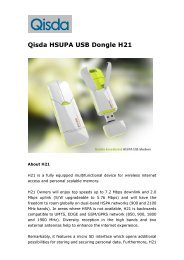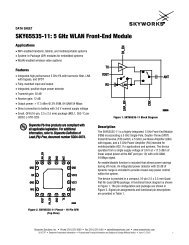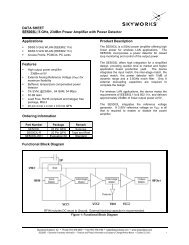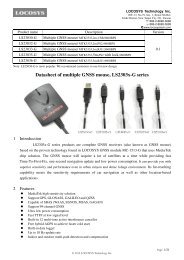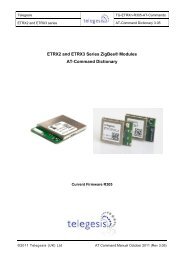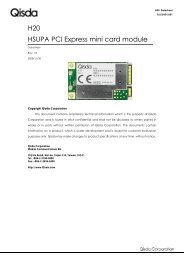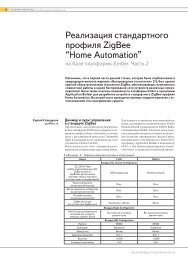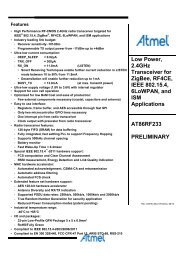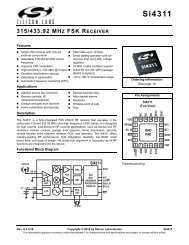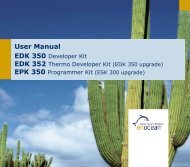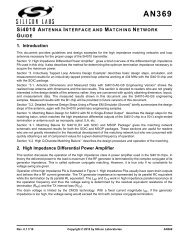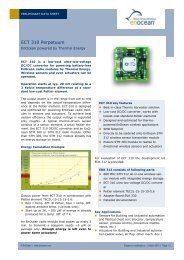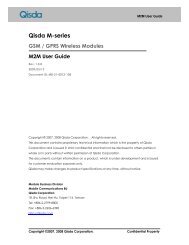Bluetooth Commands - wless.ru
Bluetooth Commands - wless.ru
Bluetooth Commands - wless.ru
You also want an ePaper? Increase the reach of your titles
YUMPU automatically turns print PDFs into web optimized ePapers that Google loves.
Chapter 1 – Introduction<br />
Multi-Point (MP) Architecture<br />
Using Multi-Point Mode<br />
The ATMP supports any combination of Client/Server connections up to a maximum of 4. The modules are<br />
shipped and factory-defaulted as Slaves supporting point-to-point connections. The PIO functionality is the<br />
same as previous releases when in this mode. By using the AT Command ATSSW,3 you can increase the<br />
number of <strong>Bluetooth</strong> connections. However, when you set the module to multiple channels, we automatically<br />
reassign the following PIOs:<br />
Channel 00 – PIO(2), Channel 01 – PIO(5), Channel 02 - PIO(7), Channel 03, PIO(8). PIO(5) will no<br />
longer toggle at 1Hz.<br />
To maintain backwards compatibility, we maintain the same commands for point-to-point configuration.<br />
<strong>Commands</strong> like ATRSSI are the same; but, while in Multi-Point mode, we added the Letter “C” for ATRSSIC,2<br />
to indicate the remote channel number to request this information from.<br />
When the module is setup for more than one connection, the connections are all in regular data mode. You<br />
cannot command the connection(s) in Fast Data Mode because the internal parser needs to interpret where<br />
the data is originating from. So, in Multi-Point Mode, there is no such thing as Fast Data Mode. If you are<br />
communicating to the ATMP local hardware UART in command mode and an incoming remote connection is<br />
established, then the ATMP automatically goes into data mode and is no longer in command mode. You will<br />
want to monitor the PIO Connect Channel Status Lines to make sure what state the ATMP is in.<br />
As you are transmitting or receiving data to any given channel, the average inquiry and connection time for<br />
each additional connection roughly doubles in time. This occurs because the CPU is busy processing data on<br />
each additional channel; this consumes more and more resources with each connection. Therefore, we<br />
cannot spec the data throughput or overall system performance since it depends on so many independent<br />
and dependant variables related to the number of connections, to the time the connection was established,<br />
how much data is being processed, and whether or not the ATMP is being queried by other nearby <strong>Bluetooth</strong><br />
devices. A typical design implementation should be one in which data is not transmitted or received<br />
simultaneously from all connections in order to prevent the CPU from crashing.<br />
Note: Multi-Point mode will be overridden by FTP or OPP modes. If the radio makes a client FTP or OPP<br />
connection or is configured as an FTP or OPP server, the radio will no longer be in Multi-Point mode.<br />
Receiving Data in Multi-Point Mode<br />
When receiving data in Multi-Point mode, a typical interleaved UART data stream for 4 <strong>Bluetooth</strong><br />
connections coming in on 4 separate channel identifiers will look similar to the following example<br />
depending on the order in which they were sent from the remote units to the ATMP:<br />
00,data payload123456789001,data payload1234567890123456789002,data<br />
payload12345678901234567890123456789003,datapayload12345678901234567890123456789<br />
0123456789002,data payload123456789012345….<br />
The data payload size is not fixed and is variable in length. The channel header, 0#, will be sent<br />
whenever data from another channel comes in. The # character represents the channel number of the<br />
following data. The header is only sent once if no other channel reports in during the period to lower<br />
the communications overhead of the protocol. The ATMP Server needs this method to identify the<br />
origination of incoming data for a single physical hardware output UART on the ATMP radio;<br />
therefore, data is interleaved as shown above.<br />
Transmitting Data in Multi-Point Mode<br />
By default, data is broadcast to all connected radios when the local radio is in data mode. The radio can<br />
be set to transmit to a specific channel using the ATSWC command. (See the Utilities section for more<br />
information).<br />
Multi-Tech Systems, Inc. SocketWireless <strong>Bluetooth</strong> AT <strong>Commands</strong> (S000360G) 10



